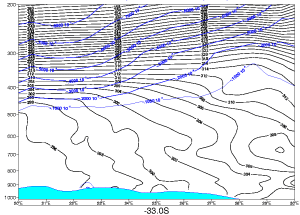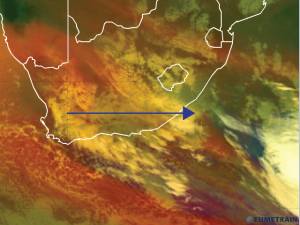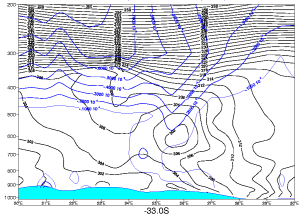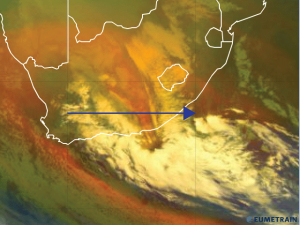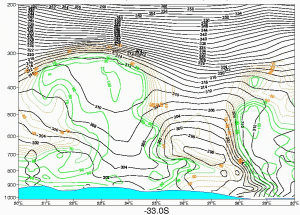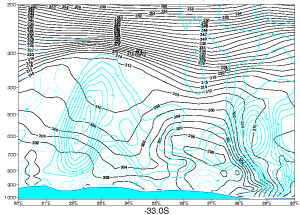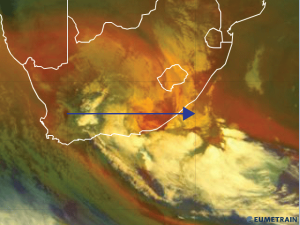Typical Appearance In Vertical Cross Sections
The NWP parameters that describe the vertical structure of the Conceptual Model:
-
Potential vorticity
You will be looking for times when you start to see values of negative PV in the upper atmosphere, and then descending towards the surface. This will indicate the depth and vertical extent of the COL. -
Relative humidity
The highest relative humidity values should be coincident with where the deepest convection is occurring, as well as where the thickest stratiform cloud is occurring. Such cloudy areas are important to locate in order to understand where the highest risk of heavy precipitation is located. -
Vertical Velocity (Omega)
Negative values of Omega are indicative of where uplift is occurring, which is an important factor when locating ares of convective development and potentially heavy falls of precipitation.
An important point to note, would be that the NWP products should be viewed along side one another and not in isolation. The coincidence of areas with high relative humidity, vertical uplift and negative values of potential vorticity, will be the areas favoured for the most active convective precipitation.
All vertical cross sections below were done on a constant latitude line of 33deg south, and between 20deg East and 30deg East in longitude. an example is given below.
Potential Vorticity 13 July 2012 12UTC
|
A vertical cross section of ECMWF Equivalent potential temperature overlaid with Potential vorticity along a constant line of latitude at 33° South valid for 13 July 2012 at 12UTC.
|
|
|
On the 13th July at 12UTC, the lowest values of PV were found between 22 and 23deg longitude, which is over the south-western interior of South Africa. the lowest values are observed at approximately 250hPa, which is a typical pattern for COL pressure systems, as the low pressure originates in the upper atmosphere and extends toward the surface over time.
|
|
Potential Vorticity 14 July 2012 06UTC
|
A vertical cross section of ECMWF Equivalent potential temperature overlaid with Potential vorticity along a constant line of latitude at 33° South valid for 14 July 2012 at 06UTC.
|
|
|
18 hours later, at 06UTC on the 14th July, negative PV is extending from the upper levels towards the surface, and is evident as low as 600hPa at a longitude of 25.5°. This is evidence of the COL intensifying while over land, and progressing eastward with time. Lowest values of PV are still found between 21 and 22° East, around 200hPa. considering that COL pressure systems are baroclinic systems, this orientation of a westward displacement of a low pressure system with height, is consistent with what is expected.
|
|
Relative Humidity 14 July 2012 12UTC
|
A vertical cross section of ECMWF Equivalent potential temperature overlaid with Relative Humidity (%) along a constant line of latitude at 33° South valid for 14 July 2012 at 12UTC.
|
|
|
The depth of highest values of Relative humidity is found between 23 and 24° East, extending from the surface until nearly 300hPa. this area of deep moisture is located west of where the COL is extending to the mid levels of the atmosphere, as seen in the potential vorticity field above. The dry area seen in the relative humidity field, between 26 and 28° East, is coincident with where the surface low pressure system is located in the satellite imagery.
|
Potential Vorticity 14 July 2012 06UTC
|
A vertical cross section of ECMWF Equivalent potential temperature overlaid with Vertical Velocity (Omega) along a constant line of latitude at 33° South valid for 14 July 2012 at 12UTC.
|
|
|
Maximum uplift is found between 500hPa and 600hPa at a longitude of 22° east. in this area, the uplift extends from the surface, vertically to above 300hPa. such a deep zone of uplift is very favourable for convective development. a similarly deep zone of uplift is fund off the east coast of South Africa, at 31deg East, and is coincident with the broad band of convective cloud seen on the satellite imagery, east of the COL. the zone of uplift coincides well with where the deepest layer of relative humidity is found, as well as being east of the zone of negative values of PV which are extending to the surface, over the eastern parts of South Africa.
|
|
